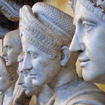TP_3_Global_p30_Reading
Pre-intermediate level
Description
Materials
Main Aims
-
To provide gist and detailed reading practice using a text about The discovery of valuable works in unusual places in the context of art
Subsidiary Aims
-
To provide fluency speaking practice in a Conversation in the context of Art and history
Procedure (21-39 minutes)
The T starts the class by showing some images of some Turkish works of art, history, and architecture asking briefly if Ss know what and where they are, no answer is confirmed or otherwise at this stage.
Now Ss work in pairs to tell each other what they know about each, or any picture while they are being shown a slide show of all the corresponding images. In case they do not have any background knowledge about them, they are encouraged to make guesses, or at least share their impression. The T stops the PW to give the turn to a feedback on content before Ss run out of fresh ideas.
The T shows further images, this time of the target vocabulary to test Ss knowledge by eliciting what they are, and if not just models the pronunciation, and drills in a whole class scale, as well as individually.
Now the T gives them instructions to quickly match some pictures with some words to be given, Ss are then given the vocabulary of page 30, exercise 1 together with hard copies of similar pictures to which they were shown earlier. Next the T asks Ss to check in pairs, then elicits their answers, checks, and gives extra help in necessary.
The T puts the four reading paragraphs into two pieces of paper and puts them on different walls. Then puts Ss into two equal groups, introduces the topic "discovered", elicits the meaning, and instructs them to stand up and read as much as they can about the text in 40 seconds.
Now the T asks Ss to pair up with a classmate of the other group and share with each other what they understood from the text. Then the T does the feedback and elicits ideas but does not give any comments.
Now the T puts another copy of the paragraphs, separated on a different wall than the previous stage, puts Ss in four groups and asks them to go to the board, where they can find pictures of exercise 1 on pages 30 and 31, and put them quickly, in 1 minute, on the corresponding text and sit down. The T then checks the answers as a whole class.
The T gives each S a HO which is in essence a glossary of the new words of the paragraph belonging to that group, and asks them to match words with their definitions, check answers with their partner(s) Then they all check together with the teacher calling the words aloud and asking for correct definitions.
Ss are instructed to work on their own to read the text more carefully though quickly, to complete two sentences about their text. Then in each group of four, they are individually given a HO containing two gap-fill sentences. They are now asked to check with their partner(s). After that the T does a whole class feedback on the board using the projector, eliciting the answers and completing the sentences.
Ss are regrouped at first into two general groups of A and B, then the T gives group A instructions to look at the word they will be given and choose a suitable part-of-speech for it, and group B to look at their incomplete sentence and decide what part of speech they will need to complete their sentence. Now Ss are asked to stand up and find a partner from the other group who has a matching word/sentence with what they are looking for. In the end the T quickly goes through the feedback as a whole class.
First the T gives each S a paper of their choice (different in each pair), of A, or B. A papers contain speaking question set A, and those of B contain question set B. Then Ss are asked to work in pairs to ask their questions and try to remember their ideas. When about 80 percent of Ss have finished, the T asks what artistic present each S would buy for their partner on their birthday, and why.

